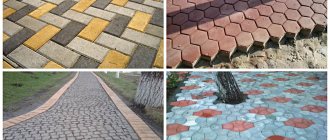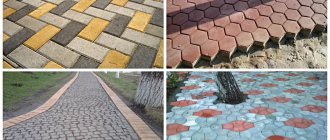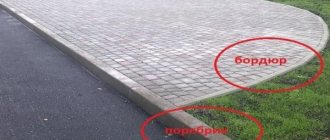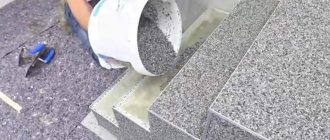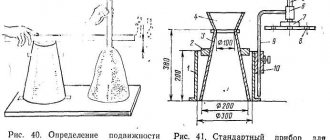Roads are considered the “arteries” of a complex “organism” of any country. The percentage of emergency situations that occur primarily depends on their quality. When designing a road, a number of factors are taken into account: future load from vehicles, natural conditions, proximity to groundwater, and even human economic activity in the area where the roadway is laid. It is not enough just to lay good asphalt; it must be repaired in a timely manner and properly maintained. Well-established transport links provoke the emergence of new settlements or the revival of old ones, the construction of industrial and commercial facilities, as well as the development of human economic and cultural activities. Accordingly, new roads play the role of an active participant in the development of society in various directions. There are several options for laying the road, and the process of its construction is complex and multi-stage. Let's consider whether in reality or not, the technology of asphalting roads is complex.
Types of asphalting
At the moment, road paving technology comes in two types. These types received their names in accordance with the temperature of the asphalt concrete mixture that is used for them.
- Hot method.
- Cold method.
The difference in the degree of viscosity of bitumen in different types of mixtures, which determines the temperature regime of installation. The cold mixture method is being used more and more often. It has a number of advantages:
- It can be used in winter and rainy weather.
- There is no need to constantly maintain the temperature of the mixture.
But, unfortunately, this method is only convenient for routine repairs. When building a new road or during major repairs, specialists still use the old, reliable method of hot asphalt paving. It is the hot mixture that is distributed better over the surface and is well compacted; accordingly, we can talk about longer service life of such a road surface. Before use, the hot asphalt concrete mixture must be at a strictly defined temperature (not lower than 120 degrees). To maintain it, special equipment is used. When the temperature drops to a certain level, the mixture is considered spoiled and unsuitable for use.
It’s interesting to know: by the way, previously there was also a third technology for paving roads, but in the 2000s this definition disappeared from official terms. The introduction of the new GOST left room for only two technologies, recognizing the third as ineffective and therefore unviable. “Warm” asphalt paving was carried out at a mixture temperature of at least 70 degrees. Liquid and viscous bitumens were used as the liquid base in these mixtures.
Laying technology
Before we begin describing the installation technology, it is worth recalling the tools that will be needed during construction work. The first thing you should take care of is a mobile thermos boiler with heating and a mixing system. This equipment is necessary for moving hot asphalt mixture.
You will also need an asphalt paver. It is used to distribute hot mass over the road surface.
When performing road work, you will also need hand tools. In particular, in the process of laying hot asphalt it is impossible to do without trowels, draggers and rakes. Finally, you will need a roller or vibrating plate to compact the road surface. In some cases, manual tamping technology may be used.
As for the installation process itself, it consists of several stages. First, preparatory work is carried out. They involve leveling the area and removing any excess vegetation. After this, an earthen trough is prepared for backfilling with a base of crushed stone and sand. In general, the sand-crushed stone substrate should be no thinner than 5 centimeters. Its task is to create a load-bearing layer that will withstand enormous loads. In addition, it will serve as drainage, protecting the road surface in the event of rising groundwater.
Next, the asphalt layer is laid. Depending on the planned load level, there may be several such layers. Additionally, a bitumen mixture is used to ensure better adhesion between the layers. According to generally accepted standards, the final thickness of asphalt should be at least 8 cm.
Features of materials
Asphalt concrete is a mixture used in the construction of road surfaces, the composition of which is optimally selected based on minerals. The following minerals are used: sand, crushed stone, liquid bitumen or bitumen emulsion, mineral powder. In accordance with GOST, depending on what stone material underlies it, the mixture is classified into three types:
- Sandy.
- Gravel.
- Crushed stone.
Read on topic: Construction of high-speed highways
There is another classification, which is based on the size of the mineral grains in the mixture:
- Fine-grained.
- Sandy.
- Coarse-grained.
In this case, cold mixtures can be exclusively sandy or fine-grained. There are also three more groups based on the percentage of gravel or crushed stone content (stone component):
- Group B about 30-40%.
- Group B about 40-50%.
- Group A is about 50-60%.
It is the solid “ingredients” of the asphalt mixture that, after rolling, fill all the resulting air cavities.
There is also an exclusively “hot” classification based on the residual porosity of the material, that is, according to the percentage volume of “pores” in the material after its compaction. It, as you already understood, is used only for hot mix asphalt concrete:
- Porous.
- Dense.
- Highly porous.
- High density.
Asphalt concrete mixture is used not only as a base for road surfaces, although here it has established itself as one of the most reliable and economical materials. Asphalt is used to cover squares, airfields, garden paths, private courtyards and floors in industrial premises.
Interesting to know: all types of asphalt are divided into two types: natural and artificial. Artificial ones are used everywhere. When driving around the city, you are dealing with artificially created asphalt. Natural ones are formed after the evaporation of oil and consist of its heavy residues.
Asphalt consumption per 1 m2
Very often, road workers who have to lay an asphalt concrete mixture wonder how much of this mixture needs to be ordered so that it doesn’t end up with a car of already cooled asphalt that needs to be urgently disposed of somewhere.
So what does asphalt consumption depend on?
First of all, the type of asphalt concrete mixture.
For crushed stone-mastic asphalt concrete mixtures (SCMAS), the consumption will be the highest - about 25.5 kg per 1 centimeter of thickness. This is explained by the optimally selected continuous curve of the particle size distribution of SMAS (high degree of filling of the frame with crushed stone grains of various sizes).
Consumption per 1 m2 for cold asphalt will be 25 kg (1 cm thick).
For coarse-grained mixtures it will be less - about 24 kg per cm, due to the fact that, according to GOST, their granulometric curve is discontinuous, i.e. between large grains of crushed stone, the space is filled with sand, and not with small fractional screenings of crushed stone, as in the case of the production of ShchMAS.
For sandy ones - about 23.5 kg, since the density of sand is less than the density of crushed stone.
The figures that we have given you are approximate and will always change slightly upward or downward depending on the type of crushed stone or sand used, since the densities of mineral materials and their strength physical and mechanical characteristics vary depending on the place of extraction( career).
If you need to asphalt an area with ShchMAS-20 with a total area of 500 m2, 4 cm thick, then your entire calculation will come down to a simple formula:
Hot way
The hot mixture is known for its “staying power”. It is capable of withstanding enormous loads, therefore it is used for the construction and repair of busy roads with high vehicle traffic. To prepare the mixture, it is necessary to ensure a temperature of 100-130 degrees. It is strictly forbidden to exceed or lower the temperature level, so you cannot do this without special equipment. When pouring mineral powder and crushed stone, the temperature should already reach 100 degrees. At the same time, the bitumen is heated to a boil. The components are continuously mixed. The mixture is immediately delivered to the work site or mixed immediately “without leaving the cash register.” Asphalt must also be laid quickly. The creation of “seams” is unacceptable. Subsequent layers should be laid on top of the previous one, which is still hot. When working with hot mixture, it may “stick” to the roller. To avoid this, the coating is constantly moistened with water. To use such a “sensitive” material, a team of specialists is needed to ensure coordinated work.
Read on topic: Construction control of roads
Cold way
The cold method began to be used not so long ago, but its convenience has already been appreciated by most road repair and construction companies. The use of a cold mixture allows the coating to be used immediately after installation, which is most convenient for urgent repairs in areas of busy road sections: intersections, large road junctions, in front of traffic lights. This road paving technology allows the mixture to be used in bad weather. Rain or snow will not interfere with the laying of cold asphalt. This mixture can also withstand strong temperature changes: from +50 to -25 degrees.
As you can see, neither severe frosts nor “hellish heat” will become an obstacle to high-quality road work. The cold mixture is simply stored in special packaging at room temperature. There is no need to carry out any manipulations with it; it is already ready for use. This material is used only for repair work. It is quite expensive. Unfortunately, its strength also leaves much to be desired, which is why cold mix is not used in the construction of highways and main roads. Although the characteristics of the material state that it can be laid at high temperatures, the strength of the coating suffers greatly in the summer.
What stages does road paving technology include?
Repairing or building a new road always begins with design. This stage is the very first and one of the most important. An incorrectly designed road may subsequently lead to the need for its replacement and re-construction. Therefore, in order not to join the ranks of those very misers who pay twice, it is better not to skimp on design. Then the area under the road is carefully cleared of vegetation. Then, with the help of loaders and bulldozers, the top layer of soil is removed. The surface of the resulting “trench” is leveled with graders. In accordance with the marks, a so-called road trough is formed and it is thoroughly compacted.
Read on topic: Types of asphalt
The next step will be the formation of the road cushion. In the future, it will be responsible for the uniform load from transport and will prevent subsidence of the road surface. The “pillow” consists of several layers of “filler”:
- Sand or a mixture of gravel and sand.
- Large crushed stone.
- Small crushed stone.
Crushed stone is poured to strengthen the entire “cushion”, and small crushed stone is needed to fill voids. All layers must be compacted with a grader. The thickness of the crushed stone layer will directly depend on the purpose of the future canvas. For example, for pedestrian paths 5 cm is enough, and for roads along which freight transport will travel, the thickness of the layer should reach 30 cm. Side stones are installed on the sides of the future road. After the formation of the “cushion” is completed, it is spilled with bitumen to better secure the future coating.
At the final stage, the builders begin directly laying the asphalt concrete mixture itself. It is either prepared immediately at the work site (most often in cases of large-scale construction) or delivered using special equipment. The mixture is evenly distributed over the “cushion” and then compacted with several asphalt pavers. Asphalt concrete is laid in several layers, which will add strength to the coating.
It is interesting to know: if we are not talking about building a new road, but about repairs, then the stage of soil preparation is replaced by the stage of removing old asphalt. The coating is processed with a milling cutter, and its damaged pieces are cut out. Subsequently, they are either collected and transported, or used for recycling in a special machine - a recycler.
Laying asphalt with a vibrating plate
Laying asphalt with a vibrating plate is a serious matter. If you decide to improve your territory, then you need to know several important rules and nuances.
Of course, you are unlikely to be able to do the concreting of your yard yourself and will invite highly professional specialists. But you should familiarize yourself with the basic criteria for laying asphalt in order to check your workers and determine whether they are slacking.
- At the beginning, it is worth determining the area for laying asphalt, indicating where and how the drainage for collecting rainwater will be arranged. Determine the composition of the asphalt of the concrete pavement:
- If the asphalt will not be subject to heavy loads (only people or bicycles will walk on it), then it is worth making a coating only 10 cm-15 cm thick.
- If the asphalt will be subject to enormous loads (cars or even huge trucks will drive on it), then it is necessary to make asphalt 25-35 cm thick.
- All work begins with the so-called earthen pad (leveling the entire area with crushed stone, stone); in this case, you need to level the surface, walk over it with a roller or vibrating plate (you can rent it from us).
- The next important step is to create the concrete base:
- If your earthen cushion was only 10-15 cm, then choose crushed stone of a small fraction from 15-45 mm and such a base is made in just one layer.
- If your base is from 25-45 cm, then we recommend making it in several layers and using crushed stone of a larger fraction.
- The first layer is crushed stone of a fraction of 45-65 mm, the main task of this layer is to resist water.
- When creating the second layer, it is necessary to use crushed stone of a fraction from 25 mm to 45 mm. The main task of this layer is to create a more rational load on the base.
- To make the third layer, it is necessary to use crushed stone of a fraction from 10 to 20 mm. The thickness of the third layer can be either 3-5 cm or 6-10 cm. It is also necessary to maintain and reduce the load on the base.
- When creating, each layer must be compacted with a vibrating plate 4-6 times.
- When creating an asphalt base, it is very important to give the asphalt the desired slope for rainwater to drain. The usual specified slope does not exceed 5-10 mm per square footage.
- After you or your workers have completed the preparatory work, you can begin the asphalting itself:
- If you are paving in a microdistrict where heavy vehicles usually do not go, you can get by with a layer of asphalt of 5-7 cm.
- On a larger scale, for example, medium traffic roads, you need to make 2-3 layers of 5-6 cm each.
- In addition, if you need to install curbs, do it before asphalting. If you have a large amount of work, we recommend delivering the asphalt mixture on a dump truck that can transport from 7 to 20 tons. One ton of the mixture produces an average of 10-11 square meters of asphalt pavement with a thickness of 4-5.5 cm.
- After the asphalt has been delivered, it begins to be leveled and compacted using vibrating plates, a roller and a vibratory rammer. Laying asphalt is highly dependent on weather conditions, for example, it is impossible to lay asphalt in rainy weather, since the asphalt solution is a hot product when it cools, it hardens, it is delivered from the plant for its production very quickly to the construction site and it also needs to be unloaded very quickly, it is especially difficult to do this in winter frosts. Therefore, asphalt paving is rarely carried out in winter, because it is a very disastrous business. The employer will immediately have a huge number of questions regarding the quality of the road surface.
In conclusion, it is worth noting that if all the rules are followed, your asphalt pavement will last from 8 to 11 years.
You can rent any construction tool from us.
01.08.2014
